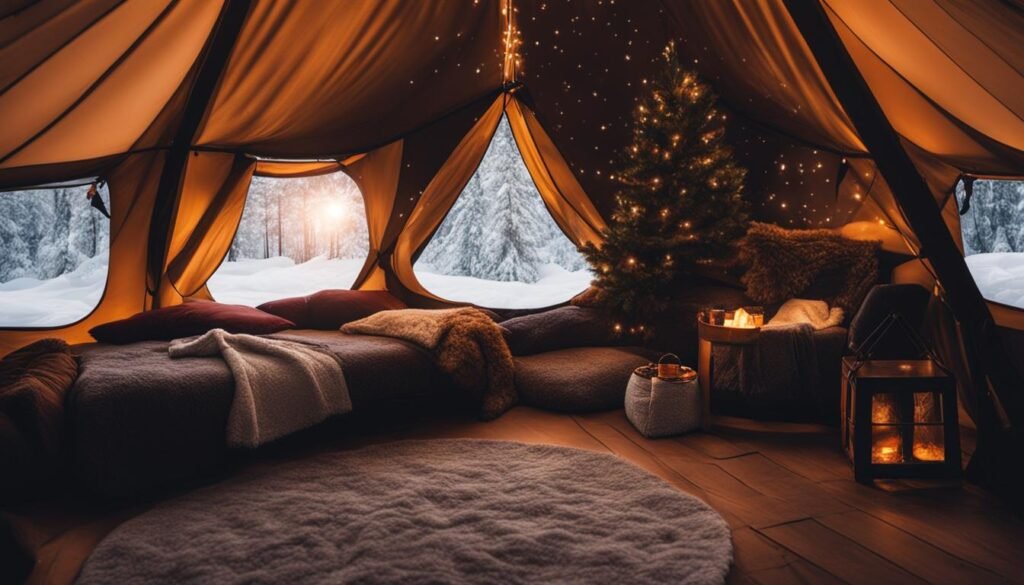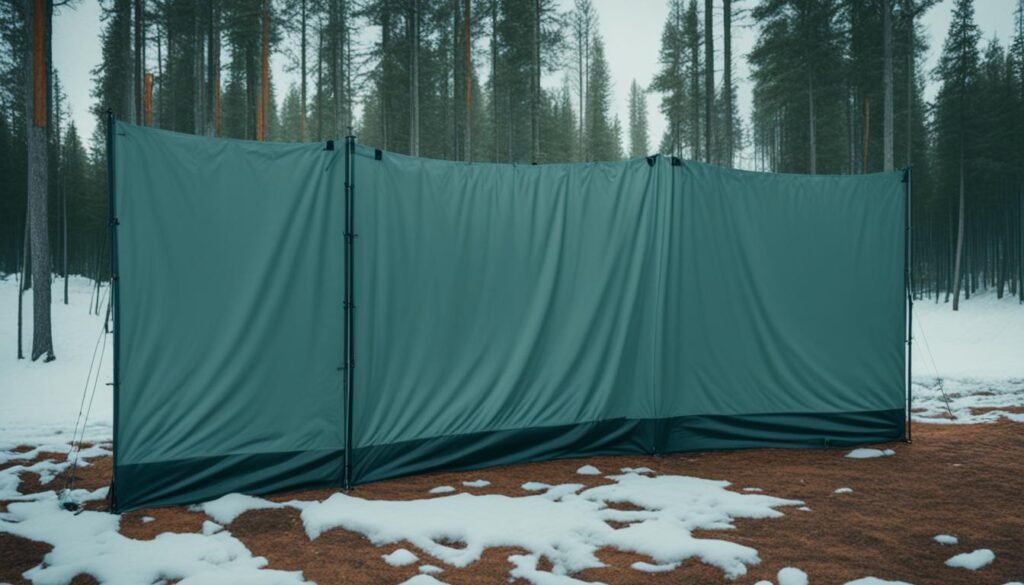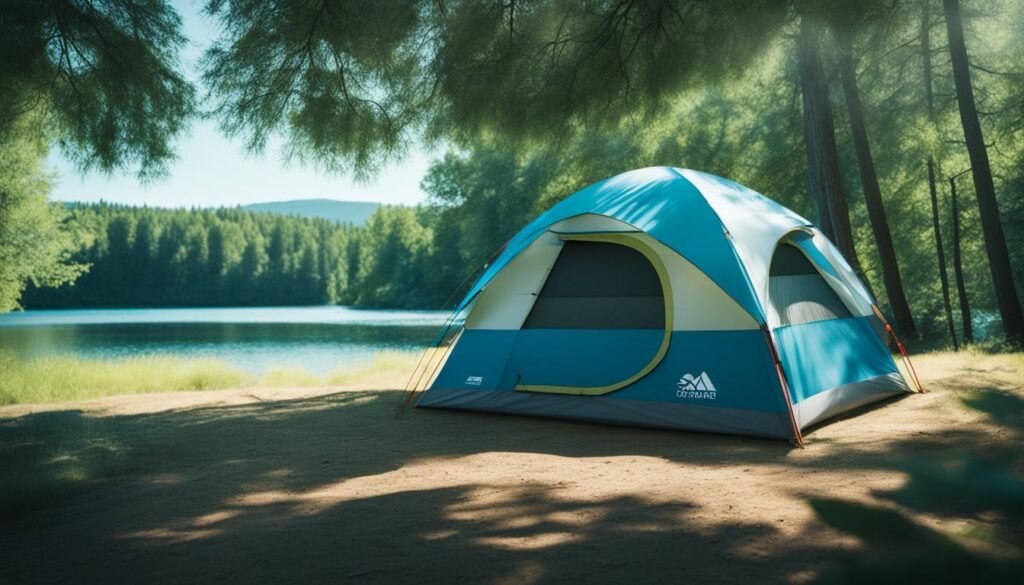Converting a summer tent for winter use requires proper insulation and preparation. Whether you’re planning a cold weather camping trip or want to enjoy the snowy outdoors, transforming your tent into a winter-ready shelter is essential for a comfortable and enjoyable experience.
Key Takeaways:
- How to make a summer tent into a winter tent
- Winterize tent for cold weather camping
- Tent insulation tips and winter camping hacks
- Gear recommendations for winter tent
- Tent heating solutions for camping in the snow
Selecting the Right Tent for Winter Camping
When converting a summer tent for winter use, it’s vital to choose a tent specifically designed for harsh winter conditions. Four-season camping tents are built to withstand the challenges of winter camping and offer superior insulation and protection. Here are some top tent brands that offer reliable options for winter camping:
- Mountain Hardwear: Known for their durable and high-performance outdoor gear, Mountain Hardwear offers a range of four-season camping tents that excel in winter conditions.
- NEMO: NEMO creates innovative camping equipment, including winter tents that prioritize insulation, durability, and weather resistance.
- The North Face: A pioneer in the outdoor industry, The North Face produces winter tents that combine cutting-edge technology with excellent craftsmanship, ensuring optimal warmth and protection.
- Hilleberg: Renowned for their sturdy and reliable tents, Hilleberg specializes in manufacturing durable four-season tents suitable for extreme winter environments.
By investing in a tent from one of these reputable brands, you can have peace of mind knowing that your winter camping experience will be safe and comfortable.
Adding Ground Insulation
To insulate your tent from the cold ground, there are several effective methods you can employ. One essential step is to use a tent footprint underneath your tent. This provides an additional barrier between the ground and your tent, preventing moisture from saturating the tent floor. A tent footprint also protects the bottom of your tent from abrasions and punctures.
Another effective way to add ground insulation is by using foam sleeping pads. These pads not only offer cushioning for a more comfortable sleep but also provide insulation from the cold ground. Look for sleeping pads with insulation and an appropriate R-value, which indicates the pad’s ability to resist heat transfer. Placing the foam sleeping pads on top of the tent footprint enhances the insulation properties.
In addition to the tent footprint and foam sleeping pads, you can further enhance ground insulation by adding a thick blanket or rug inside the tent. These materials act as an extra layer of insulation between you and the ground, helping trap warmth inside the tent.
“Proper ground insulation is crucial for winter camping. It helps prevent heat loss through the floor and keeps you warm and comfortable throughout the night.” – Outdoor Expert
By employing these ground insulation methods, you can create a cozy and well-insulated environment inside your tent, even in the coldest winter conditions. Now that you have taken care of the ground insulation, let’s move on to other important aspects of preparing your tent for winter camping.
Setting Up a Wind Break
Protecting your tent from icy winds is crucial for staying warm during your winter camping adventure. Whether you’re camping amidst glorious snowy landscapes or bracing the chill in a colder region, having a reliable windbreak can make a significant difference in your comfort level. In this section, I’ll guide you through setting up a wind break to shield your tent from those biting winds.
When it comes to creating a wind break, there are two main options: a natural windbreak or utilizing a tarp or rainfly. Let’s explore both:
1. Natural Windbreaks
A natural windbreak is any naturally occurring barrier that can block or redirect the wind away from your tent. Here are a few ideas to consider:
- Large rocks or boulders: Arrange these strategically around your tent to create a physical barrier against the wind.
- Shrubs or trees: Position your tent closer to a cluster of shrubs or trees as they can help break the wind’s force and act as a natural windbreak.
2. Tarp or Rainfly
If a natural windbreak is not available or sufficient, you can use a tarp or rainfly to create an effective barrier against the wind. Here’s how:
- Select a sturdy tarp or rainfly that is large enough to cover the side of your tent that is most exposed to the wind.
- Secure the tarp or rainfly to your tent’s guylines or attach it to nearby trees or other stable structures. Ensure it is pulled taut and well-anchored.
- Position the tarp or rainfly so that it blocks the wind from hitting your tent directly, redirecting the airflow away from your shelter.
It’s essential to tune into local weather forecasts to determine the anticipated wind direction. This will help you position and orient your windbreak for maximum effectiveness. Additionally, be sure to check the weather throughout your camping trip as wind patterns can change.
Always remember: A properly set up windbreak can significantly reduce the chill factor inside your tent, providing a more cozy and comfortable camping experience.
Now that you know how to set up a wind break, let’s move on to the next section where we’ll discuss adding a secondary cover to the top of your tent to further enhance insulation and warmth.
Adding a Secondary Cover to the Top of Your Tent
When it comes to winter camping, every extra layer of insulation helps in keeping the cold at bay. Adding a secondary cover to the top of your tent can significantly improve its heat retention capabilities. There are a few options to consider for this purpose.
1. Thermal Blanket: A thermal blanket is an excellent choice for providing additional warmth to your tent. These blankets are designed to reflect your body’s heat back into the tent and help trap the warmth inside. They are lightweight and easy to pack, making them a convenient option for winter camping.
2. Second Rainfly or Tarp: Another option is to add a second rainfly or tarp on top of your tent’s existing rainfly. This creates an extra layer of insulation and provides waterproofing as well. Make sure to secure it tightly to prevent any gaps that might allow cold air to seep in.
Tip: Choose a tarp or rainfly that is slightly larger than your tent’s dimensions to ensure proper coverage and protection.
3. Foil Thermal Blanket: Foil thermal blankets are specifically designed for thermal insulation in various environments, including winter camping. These lightweight and compact blankets have a reflective metallic surface that helps retain heat. They are often preferred by experienced campers for their efficiency in trapping warmth.
Adding a secondary cover to the top of your tent not only provides insulation but also acts as an additional barrier against snow, rain, and wind. Ensure that the secondary cover is properly secured and does not obstruct any ventilation openings in your tent.
Remember, while adding a secondary cover can help retain heat, it is essential to maintain proper ventilation inside your tent to prevent condensation and ensure a comfortable camping experience.
| Pros | Cons |
|---|---|
| Provides additional insulation and heat retention | May require extra setup or additional gear |
| Enhances waterproofing capabilities | May restrict ventilation if not properly adjusted |
| Lightweight and easy to pack | Requires proper securing to prevent gaps |
| Reflects body heat back into the tent |
Stringing Up a Tarp Over Your Tent
When it comes to camping in wet conditions, protecting your tent from moisture is crucial for a comfortable and dry experience. One effective method is to use a tarp as an additional layer of defense against rain, snow, and condensation. By covering your tent with a generously-sized tarp and securing it properly, you can create a reliable barrier that helps keep you and your gear dry.
Here are some key steps to follow when stringing up a tarp over your tent:
- Choose the right tarp: Select a durable and waterproof tarp that is large enough to cover your entire tent. Look for tarps specifically designed for outdoor use and ensure they are made from high-quality materials that can withstand harsh weather conditions.
- Pitch the tarp: Find suitable anchor points such as nearby trees or rocks to attach the tarp. It’s essential to leave some room for sag to prevent water from collecting on the tarp. Pitch the tarp with one side slightly lower than the other to allow water to run off easily.
- Secure the tarp: Use sturdy ropes, bungee cords, or straps to secure the tarp tightly to the anchor points. Check the tension regularly to ensure the tarp remains taut and doesn’t sag or flap in the wind. This will prevent water from pooling on the tarp and potentially leaking into your tent.
- Pitch the tarp away from the tent: Ensure that the tarp is pitched in a way that sheds water away from the entrance of your tent. This will help prevent water from seeping under the tarp and reaching your tent’s interior. Positioning the tarp at a slight angle can facilitate water shedding.
By following these steps, you can effectively use a tarp to provide an additional layer of protection for your tent, keeping you dry and comfortable throughout your camping trip. Remember to regularly inspect and maintain the tarp to ensure it remains secure and functional.
Lining The Interior with Insulating Fabric
To further enhance the insulation of your tent, consider lining the interior walls and roof with fleece blankets. Fleece is an excellent insulating material that helps retain heat and keeps you warm during cold winter nights.
To ensure a snug fit, creatively secure the blankets to the tent’s interior, leaving a small gap for easy entry and exit. This gap allows for proper airflow and ventilation, which is essential in managing moisture and reducing condensation inside the tent.
The use of insulating fabric like fleece blankets not only adds an extra layer of warmth but also helps to prevent the transfer of cold air from the outside. By minimizing heat loss and reducing condensation, you can create a more comfortable and cozy environment inside your tent.

Benefits of Lining the Tent’s Interior:
- Enhanced insulation to keep you warm
- Reduction of condensation and moisture build-up
- Improved comfort and coziness
By taking this simple yet effective step, you can significantly improve the warmth and comfort of your tent during winter camping trips.
| Advantages of Using Fleece Blankets for Lining | Considerations for Securing Blankets |
|---|---|
|
|
Utilizing a Safe Tent Heater
When camping in winter, staying warm is essential for a comfortable experience. While not always recommended, using a tent heater can provide much-needed warmth inside your tent. However, it is crucial to prioritize safety and take necessary precautions to prevent accidents.
One popular option for winter camping is electric space heaters. These heaters tend to be safer compared to other types, such as propane heaters, as they don’t produce carbon monoxide or require an open flame. Before purchasing an electric space heater, it’s important to research and ensure that your tent manufacturer allows their use. Some tents may have specific guidelines regarding tent heater usage.
To ensure tent heater safety, here are some precautions to keep in mind:
- Always follow the manufacturer’s instructions for your tent heater and use it in accordance with the guidelines provided.
- Place the heater on a stable surface, away from any flammable materials like bedding, clothing, or curtains.
- Never leave the tent heater unattended while it is in operation.
- Keep the heater away from children and pets to avoid any accidents.
- Consider using a tent heater with built-in safety features, such as tip-over protection or an automatic shut-off system.
Remember, using a tent heater should always be done with caution. It is essential to prioritize your safety and the safety of those around you. Properly researching and selecting a tent heater that meets your tent manufacturer’s guidelines will help ensure a warm and enjoyable camping experience.
Stay warm and cozy in your tent during your winter camping adventures!
| Tent Heater Safety Precautions |
|---|
| Follow the manufacturer’s instructions |
| Place the heater on a stable surface |
| Keep the heater away from flammable materials |
| Never leave the heater unattended |
| Keep the heater away from children and pets |
| Consider heaters with built-in safety features |
Choosing the Right Sleeping Bag
When it comes to winter camping, a high-quality and well-insulated sleeping bag is essential for a comfortable and warm night’s sleep. Here are some important factors to consider when selecting your winter sleeping bag:
- Temperature Rating: Look for a sleeping bag with a temperature rating suitable for the lowest temperature you expect to encounter. The temperature rating indicates the minimum temperature at which the bag can keep you warm.
- Sleeping Bag Liner: To add extra insulation and warmth to your sleeping bag, consider using a sleeping bag liner. These liners can increase the warmth of your sleeping bag by 10-15 degrees, providing an extra layer of coziness.
Comparing Temperature Ratings
| Sleeping Bag Brand | Temperature Rating | Insulation Type |
|---|---|---|
| Brand A | -15°C to -25°C | Synthetic |
| Brand B | -20°C to -30°C | Down |
| Brand C | -10°C to -20°C | Hybrid |
“Investing in a high-quality winter sleeping bag with a temperature rating suitable for your needs is crucial for keeping warm and comfortable during cold nights in the wilderness.” – Expert Camper
Choose a sleeping bag that suits your winter camping needs and provides the required level of insulation to ensure a cozy and restful night in the great outdoors.
Warming Yourself with Heat Packs
When camping in winter, staying warm is essential for a comfortable and enjoyable experience. One effective way to add warmth to your sleeping bag is by using heat packs. These compact accessories are designed to provide heat and can be easily placed inside your sleeping bag to create a cozy environment.
To maximize the effectiveness of heat packs, follow these tips:
- Place the heat packs on top of your thermal layers. This allows the heat to transfer directly to your body, keeping you warm throughout the night.
- You can also tuck the heat packs inside wool socks before putting them on. This helps to keep your feet warm, as they can be particularly susceptible to cold temperatures.
Heat packs are a convenient and safe way to add extra warmth to your sleeping bag without the need for electricity or open flames. They are especially useful for winter camping trips when the temperatures can drop significantly.
In addition to using heat packs, it’s important to dress in thermal layers and wear a head covering like a beanie for added insulation. These warming accessories, combined with the heat packs, will help you stay cozy and comfortable even in the coldest winter nights.
Comparison of Different Heat Packs
| Heat Pack Brand | Duration of Heat | Size | Price | Special Features |
|---|---|---|---|---|
| Brand A | 8-10 hours | Small | $X.XX per pack | Adhesive backing |
| Brand B | 12-14 hours | Medium | $X.XX per pack | Odorless |
| Brand C | 6-8 hours | Large | $X.XX per pack | Quick activation |
Using the Hot Water Bottle Trick
Keeping your feet warm during winter camping is essential for a comfortable night’s sleep. One simple trick to achieve cozy feet is by using a hot water bottle. Here’s how you can use this handy tool to keep your feet toasty:
- Prepare the hot water bottle: Before going to bed, fill a hard plastic water bottle, such as a Nalgene, with hot water. Make sure to secure the lid tightly to avoid any leakage.
- Place the bottle in your sleeping bag: Position the hot water bottle at the bottom of your sleeping bag. This allows the warmth to radiate upwards, ensuring your feet stay nice and warm throughout the night.
By leveraging the hot water bottle trick, you can create a cozy microclimate inside your sleeping bag and prevent your feet from getting cold. It’s a simple and effective way to combat the chill during winter camping.
Why it Works
The hot water bottle serves as a source of heat inside your sleeping bag, preventing your feet from becoming cold as you sleep. The warm water inside the bottle retains its temperature for a significant period, providing gentle and consistent warmth to your feet.
“The hot water bottle trick is a tried-and-tested method for keeping your feet warm during winter camping. It’s a handy solution that doesn’t require any electricity and can make a remarkable difference in your comfort level.” – Outdoor Adventure Magazine
Choosing Your Winter Camping Destination
When it comes to winter camping, choosing the right destination can make all the difference. Instead of popular summer spots, consider exploring winter camping destinations that offer unique experiences, fewer crowds, and breathtaking winter landscapes. Here are some tips to help you select your perfect winter camping destination:
- Research Winter Camping Destinations: Look for locations that are known for their winter camping opportunities. National parks, such as Yellowstone and Yosemite, often have designated winter camping areas.
- Consider Small Towns: Smaller towns in scenic areas can provide a cozy winter camping experience. These towns may offer campgrounds and facilities that cater to winter campers, as well as local attractions.
- Explore Cozy Campgrounds: Look for campgrounds that are open during the winter months. Many campgrounds offer winter amenities, such as heated restrooms and electrical hookups for RVs.
Once you’ve chosen your winter camping destination, make sure to plan ahead and pack accordingly. Consider the weather conditions and prepare for cold temperatures, snow, and icy conditions. Bring appropriate gear, such as snowshoes, warm clothing, and insulated sleeping bags.
Experience Winter Landscapes
Winter camping offers a unique opportunity to experience stunning winter landscapes. From snow-covered mountains to frozen lakes, winter wonderlands provide a picturesque backdrop for your camping adventure. Take the time to explore the surroundings, go for winter hikes, and capture the beauty of nature in its frozen glory.
Remember to take precautions and stay safe during your winter camping trip. Be aware of potential hazards and follow all safety guidelines. Stay warm by using portable fire pits or space heaters in RVs, always keeping fire safety in mind.
“Winter camping destinations offer a serene and peaceful experience, away from the crowds. It’s a chance to connect with nature in a whole new way and create unforgettable memories.” – Winter Camping Enthusiast
So, if you’re looking for a unique camping experience and want to avoid the crowds, consider venturing into the winter wilderness. Choose a winter camping destination that allows you to connect with nature and experience the beauty of winter landscapes firsthand.
Selecting the Right Tent for Winter Camping
When converting a summer tent for winter use, it’s important to consider the limitations of a three-season tent and explore the advantages of a four-season tent. Four-season tents are specifically designed to withstand the harsh winter weather conditions and provide better insulation compared to their three-season counterparts.
Four-season tents are constructed with durable materials and feature reinforced poles and extra guy lines to ensure stability in high winds and heavy snowfall. They are also designed to retain heat and prevent cold drafts from entering the tent, keeping you warm and comfortable throughout your winter camping experience.
On the other hand, three-season tents are primarily designed for use in mild weather conditions and are not as well suited to handle the challenges of winter camping. They typically have more mesh paneling, which may provide better ventilation during summer but can result in heat loss during winter.
Furthermore, four-season tents are generally smaller in size compared to three-season tents. Smaller tents are easier to heat and insulate, allowing you to maintain a warmer interior environment despite the cold temperatures outside. The compact size also helps minimize the amount of space that needs to be heated, allowing for more efficient use of energy and resources.
To ensure a safe and comfortable winter camping experience, choose a four-season tent that suits your needs in terms of size, insulation, and durability. Brands like Mountain Hardwear, NEMO, The North Face, and Hilleberg offer reliable options for winter camping. Consider the specific features and specifications of each tent to make an informed decision.
By selecting the right tent for winter camping, you can enhance your camping experience and enjoy the beauty of the winter wilderness without compromising on safety and comfort.
Note: The image above depicts a four-season tent, designed to withstand extreme weather conditions and provide better insulation during winter camping.
Insulating Your Tent from the Elements
When camping in winter weather, it is essential to insulate your tent properly to protect yourself from the elements. By creating a windbreak, building a snow wall, and covering the top of the tent, you can ensure better insulation and retain heat inside.
To create a windbreak, take advantage of natural barriers such as large rocks or shrubs that can shield your tent from icy winds. If natural windbreaks are unavailable, use a tarp or rainfly to create a barrier on one side of your tent. This will prevent cold air from penetrating your tent and help maintain a warm interior temperature.
Benefits of a Windbreak:
A windbreak acts as a protective shield, reducing the chilling effect of cold winds and minimizing heat loss from your tent. It creates a more comfortable and cozy camping environment, allowing you to enjoy winter camping without the discomfort of icy drafts.
In snowy conditions, building a snow wall around your tent can provide an additional layer of insulation. The snow wall acts as a buffer against cold air while also blocking drifting snow from entering your tent. Pack the snow firmly, creating a sturdy barrier that will help maintain the temperature inside your tent.
Another effective way to insulate your tent is by covering the top with a thermal blanket or additional insulation material. This additional layer helps retain heat and prevents it from escaping through the tent’s roof. Consider using a thermal blanket, which is lightweight and provides excellent insulation.
Benefits of Covering the Top of the Tent:
A thermal blanket or additional insulation material on the top of your tent prevents heat loss through the roof, ensuring a warm and comfortable night’s sleep. It acts as a barrier, reflecting your body heat back into the tent and creating a cozy interior environment.
By implementing these insulation strategies – creating a windbreak, building a snow wall, and covering the top of the tent – you can significantly improve the thermal efficiency of your tent and enhance your winter camping experience. Stay warm and cozy amidst the cold weather, allowing you to fully enjoy the beauty of winter camping.

Insulating Your Tent from the Ground
When preparing your tent for winter camping, it’s crucial to insulate it from the cold ground. Without proper insulation, the cold temperatures can seep through the tent floor, leaving you uncomfortable and chilled throughout the night. Here are some effective ways to insulate your tent from the ground and ensure a cozy camping experience.
Using a Tent Footprint or Groundsheet
A tent footprint or groundsheet acts as an additional barrier between your tent floor and the cold ground. It helps prevent moisture from seeping into the tent and increases insulation. Place the footprint or groundsheet underneath your tent before setting it up. This simple step can significantly enhance the overall insulation of your tent.
Using Foam Sleeping Pads
Foam sleeping pads are excellent for providing insulation and added comfort while camping in cold weather. These pads are designed to trap heat and prevent it from escaping through the ground. Place the foam sleeping pads on top of the tent footprint or groundsheet to create an extra layer of insulation. Not only will this keep you warmer, but it will also enhance the overall comfort of your sleep setup.
Using Rugs or Carpets
Another effective way to insulate your tent from the ground is by using rugs or carpets. These soft and cushioned materials provide additional insulation and create a cozy atmosphere inside the tent. Place the rugs or carpets on top of the foam sleeping pads to maximize insulation and create a comfortable surface to walk and sit on.
| Insulation Method | Benefits |
|---|---|
| Tent Footprint or Groundsheet | – Prevents moisture seepage – Increases overall insulation |
| Foam Sleeping Pads | – Traps heat and prevents heat loss – Provides additional comfort |
| Rugs or Carpets | – Adds extra insulation – Creates a cozy atmosphere |
By using a combination of a tent footprint or groundsheet, foam sleeping pads, and rugs or carpets, you can create an effective insulation system for your tent. These methods will help keep the cold ground temperatures at bay and provide you with a warm and comfortable sleep environment.
How Can I Use Insulation and Preparation Tips to Stay Warm in a Tent during Winter?
When camping in the winter, use effective insulation and preparation strategies for staying warm outdoors in a tent. Invest in a quality sleeping bag rated for cold temperatures and insulate the ground with a thick pad. Wear layers of clothing and keep hot water bottles inside the sleeping bag for added warmth.
Conclusion
In conclusion, converting a summer tent for winter use requires careful attention to insulation and preparation. By following the tips outlined in this article, you can transform your tent into a warm and comfortable shelter for winter camping.
Firstly, selecting a four-season camping tent from reliable brands like Mountain Hardwear, NEMO, The North Face, or Hilleberg is essential. These tents are designed to handle winter elements and provide better insulation.
Next, adding ground insulation with a tent footprint, foam sleeping pads, and blankets or rugs helps prevent cold air from seeping through the tent floor. Additionally, setting up a windbreak using natural barriers, tarps, or rainflies protects your tent from icy winds.
Lining the tent’s interior with insulating fabric, utilizing a safe tent heater, and choosing the right sleeping bag and winter camping accessories further enhance insulation and warmth. Finally, researching and selecting the right camping destination can ensure a memorable winter camping experience.
With these tips in mind, you can confidently convert your summer tent into a winter-ready shelter, keeping you warm and comfortable during your cold weather adventures. Stay safe and enjoy the beauty of winter camping!
FAQ
How can I convert a summer tent into a winter tent?
To convert a summer tent into a winter tent, you need to properly insulate and prepare it for cold weather camping. Follow these tips to make your tent winter-ready.
What type of tent should I select for winter camping?
It is recommended to choose a four-season camping tent specifically designed to handle winter elements and provide better insulation. Brands like Mountain Hardwear, NEMO, The North Face, and Hilleberg offer reliable options for winter camping.
How can I add ground insulation to my tent?
Use a tent footprint or groundsheet underneath your tent to create an additional barrier and prevent moisture from saturating the tent floor. Place foam sleeping pads with insulation and an appropriate R-value on top of the footprint for extra insulation. You can also add a thick blanket or rug for additional ground insulation.
How can I protect my tent from icy winds?
Look for a natural windbreak, such as large rocks or shrubs, near your tent. If that’s not possible, use a tarp or rainfly to create a windbreak on the side of your tent. Tune into local weather forecasts to determine the anticipated wind direction.
How can I add a secondary cover to the top of my tent?
You can use a thermal blanket, second rainfly, or tarp as a secondary cover for your tent. These can provide a waterproof layer and reflect your body’s heat back into the tent. A foil thermal blanket is a lightweight and effective option for winter camping.
How can I protect my tent from moisture?
Cover your tent with a generously-sized tarp and secure it to nearby trees or rocks. Leave some room for sag and pitch the tarp with one side lower to allow water to run off. Ensure that the tarp is pitched in a way that sheds water away from the tent’s entrance.
How can I insulate the interior of my tent?
Use fleece blankets to line the interior walls and roof of your tent. Secure them creatively, leaving a gap for easy entry and exit. Lining the tent’s interior with insulating fabric helps retain heat and reduces condensation on the inside of the rainfly. Proper ventilation is important to manage moisture.
Can I use a tent heater for winter camping?
While not always recommended, there are tent heaters specifically designed for winter camping. Electric space heaters tend to be safer than other types, but it’s important to research if your tent manufacturer allows their use. Follow safety precautions to prevent accidents and ensure a warm camping experience.
What type of sleeping bag should I use for winter camping?
Invest in a winter sleeping bag with a temperature rating suitable for the lowest temperature you expect. Add extra insulation and warmth by using a sleeping bag liner inside your bag. Sleeping bag liners can increase warmth by 10-15 degrees.
How can I add warmth to my sleeping bag?
Use heat packs inside your sleeping bag to add warmth. Place them on top of your thermal layers or inside wool socks. Heat packs can provide additional heat without risking safety concerns. Dress in thermal layers and wear a head covering like a beanie for added insulation.
How can I keep my feet warm in my sleeping bag?
Before going to bed, boil water and fill a hard plastic water bottle like a Nalgene. Secure the lid tightly and place it at the bottom of your sleeping bag to warm your feet. This simple trick can make a significant difference in keeping you warm throughout the night.
What are some winter camping destinations I can consider?
Research winter camping destinations and consider national parks, small towns, or cozy campgrounds. These locations offer unique experiences in less crowded settings. Stay warm by using portable fire pits or space heaters in RVs, following fire safety guidelines.
What are the differences between a four-season tent and a three-season tent?
Four-season tents are designed to withstand extreme weather conditions and offer better insulation compared to three-season tents. Smaller tents are generally easier to heat and insulate compared to larger ones.
How can I insulate my tent from the elements?
Create a windbreak using natural barriers or a tarp. In snowy conditions, build a snow wall around your tent to block cold air and drifting snow. Cover the top of the tent with a thermal blanket or additional insulation material to help retain heat.
How can I insulate my tent from the ground?
Use a tent footprint or groundsheet to insulate your tent from the cold ground. Place foam sleeping pads and rugs to further insulate the tent’s floor and provide extra comfort. Use layers of insulation both inside and outside the tent to prevent moisture and cold temperatures from seeping in.
What are the key points to remember when converting a summer tent for winter use?
When converting a summer tent for winter use, select the right tent, add ground and interior insulation, set up a windbreak, consider a secondary cover for the top of the tent, and utilize proper moisture protection. Additionally, choose the right sleeping bag, use heat packs, and research safe tent heater options if necessary.







